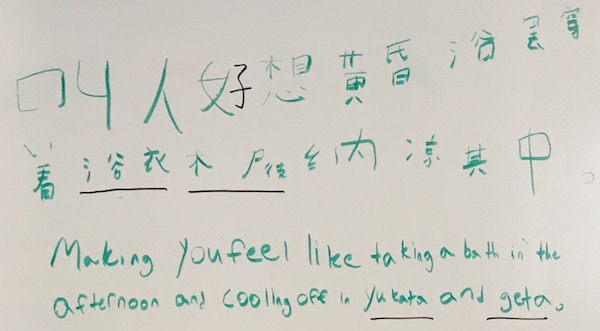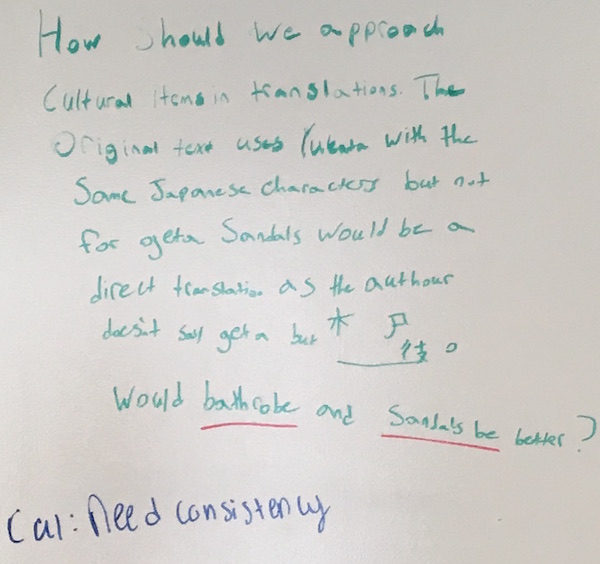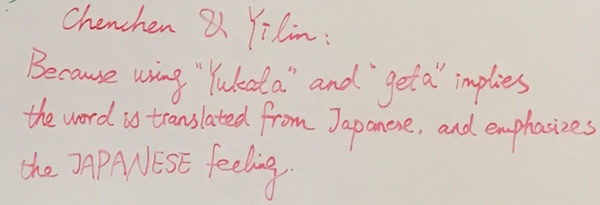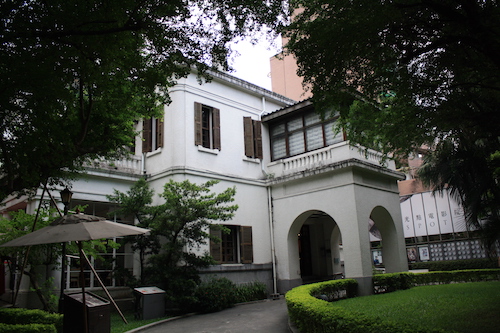Foreign Landscape
A reading route prepared by Justin (FLAC), Shuqing, Yanglu, Jenny
Image Credit: 官幣大社臺灣神社境內之圖
Throughout the novel “you” are always searching for an identity. The connections between Kyoto and Taipei as well as the numerous amounts of other culture that is part of your life is also reflected on the landscape of the city. The city is a mish-mash of Japanese, Chinese, Western, and Taiwanese culture. The city and the main character are searching for an identity in another culture. The dominant theme we have consists of both the city along with you searching for a identity. In the end though, no one culture seems to completely have the identity.
Back then, your background music, if you had a brother or sister in college, would likely be the Beatles. If it was the beginning of the 1970s, you’d be playing “Candida” nonstop, then in the next year it would be “Knock Three Times” by the same group. If it was late 1969, then you’d have listened to “Aquarius.” Every third song played on the TV show Happy Palace would be by the black group The 5th Dimension. If it was a bit earlier than that, you’d have heard “Can’t Take My Eyes off of You” by The Graduates. People who missed it then could have heard it in the bar scene in The Deer Hunter ten years later. (Page 112)
那时候的背景音乐,若你有个念大学的哥哥或姊姊,你可能多少还在听披头四。要是七○年代的第一年,那么不分时地得听Candida,以及第二年同一个合唱团的敲三下,若是六九年末,你就一定听过Aquarius,电视节目《欢乐宫》里每播三次准会出现一次的那个黑人合唱团The 5th Dimension。再早一点的话,你一定听过学士合唱团的Can『t take my eyes off you,错过这首的人,十年之后可以再在《越战猎鹿人》里的那场酒吧戏听到。
[/et_pb_vertical_timeline_item][et_pb_vertical_timeline_item title=”Stop 2″ use_read_more=”off” animation=”off” text_font_select=”default” text_font=”||||” headings_font_select=”default” headings_font=”||||” use_border_color=”off” border_style=”solid”]
For the same reason, a 10,000-cherry-tree movement was initiated during the war, hoping the islanders would, like the soldiers, fall in love with the unique, tragic, and resolute beauty of cherry blossoms. They planted an enormous number of hikan cherries, omisha cherries, double cherries on Grass Mountain, Wushe, and Nanfang’ao, which is how this particular station came to have a row of hikan cherry trees. Except for a week of hasty blooming around the Lunar New Year, their pale, bare figures were hidden under mastlike betel palms, as if inflicted with an autistic lack of confidence. Yes, there were definitely betel palms, as in a photograph of soldiers from the end of the previous century, in which an oxcart moves slowly under the shadow of trees that sway in the wind, as if cut out of paper. The corner of the photo is inscribed “Impression of the South,” making you feel like taking a bath in the afternoon and cooling off in yukata and geta. (Page 121)
他们曾在战争期间发起种植一万棵樱花运动,希望岛国人民能跟他们一样爱上那花特有的绝美惨烈,他们在草山、雾社、南方澳大量种植吉野樱、大岛樱、八重樱、绯寒樱,这车站照例便有一棵绯寒樱,除了农历年左右草草开花一星期,平日都苍白瑟索缺乏自信的自闭在一排船桅似的槟榔树下,是的,一定有槟榔树,如同征人们上个世纪末的一帧照片:几株剪影般迎风招摇的树姿间,一辆缓缓行经的牛车,照片角上的题字是「南国ソ印象」,叫人好想黄昏浴罢穿着浴衣木屐纳凉其中。

[/et_pb_vertical_timeline_item][et_pb_vertical_timeline_item title=”Stop 3″ use_read_more=”off” animation=”off” text_font_select=”default” text_font=”||||” headings_font_select=”default” headings_font=”||||” use_border_color=”off” border_style=”solid”]
Unlike your daughter, on your first visit you were surprised to find that they had brazenly, in your view, used the same name, Maruyama (Yuanshan), for the park. She, on the other hand, had gone on a kindergarten outing to the Yuanshan (Maruyama) River Park and come home to ask why we had given it a Japanese name. Stumped, you couldn’t answer, while your husband teased her about forgetting her own traditions. (Page 141)
与女儿不同的是,你第一次来圆山公园时很惊讶他们怎么公然用了你们圆山的名字。女儿却在一次幼稚园户外教学去圆山河滨公园回家后问你,奇怪怎么学人家日本人的地名呢。你突然迷惑起来不能回答,丈夫笑女儿数典忘祖。
[/et_pb_vertical_timeline_item][et_pb_vertical_timeline_item title=”Stop 4″ use_read_more=”off” animation=”off” text_font_select=”default” text_font=”||||” headings_font_select=”default” headings_font=”||||” use_border_color=”off” border_style=”solid”]
You walked down Chokushi Avenue, completed at the turn of the century, imagining you were in one of the thirteen New England states. It was all the fault of the MAAG dormitory, with its whitewashed walls, large windows, chimneys, and lush green lawn, a typical scene from a 1950s Hollywood movie. It was all the fault of off-duty GIs, who were seen on the street from time to time, and who chatted you up, gentlemanly. It was all the fault of those of you who were engrossed in the TV show Peyton Place, with its small-town affairs. If you didn’t loaf around after school, you’d get home in time to see the show. It really didn’t matter if you missed some episodes, since it had been running for more than two years and the plot hadn’t progressed much, even though you’d watched it from the age of fourteen or fifteen all the way up to seventeen. You weren’t that crazy about Ryan O’Neal, who would become famous later; you felt somehow that you were more like Mia Farrow’s character, Allison, who was intent upon leaving the small town for Boston or New York to be a writer. You felt something acutely similar between you and her, since for no identifiable reason you wanted to leave the place where you were born and raised. (Page 129)
此外还能证明的便是夹道而去的枫香,尽管它们只肯焦黄绝不嫣红,可以了,你们走在世纪初便建成的敕使街道上,幻想置身在新英格兰十三州,谁叫前行不远便是美军顾问团宿舍,五○年代好莱坞电影里典型的白墙大窗烟囱绿草坪,谁叫路上三不五时就有休假中的美军,看到你们还会绅士风度的寒暄两句,谁叫你们有几人正着迷于电视影集《Peyton Place》小城风雨,不闲荡的放学日子,回家准时可以收看得到,漏看几集也不打紧,因为已经播了两年多,剧情毫无进展的你从十四五岁都长到十七岁了,你并不着迷稍后才走红的雷恩欧尼尔,你隐约觉得自己比较像剧中那个一心想离开小城到波士顿、到纽约去圆作家梦的米亚法萝所饰名叫艾莉的女孩,你觉得自己毫无道理一意想离开生长地方的心情与她像透了。
[/et_pb_vertical_timeline_item][et_pb_vertical_timeline_item title=”Stop 5″ use_read_more=”off” animation=”off” text_font_select=”default” text_font=”||||” headings_font_select=”default” headings_font=”||||” use_border_color=”off” border_style=”solid”]
The same sort of annoying knowledge told you that the original site had sprung up out of nowhere had been a stadium built in 1923 to welcome the Showa, then still the Crown Prince, on his southern inspection trip. In the early years of the Nationalist government, it was lent to the Seventh Fleet Military Assistance and Advisory Group. On one soccer game night, the mayor-elect described his blueprint for the city’s future, in which the soccer field might be used as the site of a stadium. By then, you, along with many more sweet gum trees, would have to join ranks with Chen Weiying. (Page 160)
同样讨厌的知识告诉你,原来凭空多出的那大足球场原址是一九二三年建的运动场,为了做欢迎还是太子的昭和南巡之用,国府初期给第七舰队美军顾问团使用,刚当选的市长在足球之夜绘过未来市政蓝图,足球场也许做为巨蛋球场用地,届时,你与更多的老年枫香都将加入陈维英队伍了。
[/et_pb_vertical_timeline_item] [/et_pb_vertical_timeline]
American Influence - Music
No matter the age of the protagonist, the protagonist has culture from different countries. Her childhood and young adulthood has influences from western pop music. Even if she was able to completely inundate into Taiwanese culture or Japanese culture, she still has influences from other countries. It shows that even with the two main influences of Japanese and Taiwanese, Taiwan is not in a bubble, it gets affected by western culture as well.
Japanese Influence - Cherry Trees and Betel Palms
During the rule of the Japanese, they tried to assimilate the local people. They wanted them to feel Japanese. They mostly did this in two ways. One suppress the local culture, Two impress the locals with their own culture. They suppress the local culture through the teaching of Japanese in the schools like the Japanese teacher in “from the old country”. The other quotes show more of this. The other way they do this is impressing. They are able to impress by building 10,000 cherry trees and hope the locals would be like the Japanese and fall in love with these Cherry trees. They’re hoping they will eventually see the wisdom of “taking a bath in the afternoon and cooling off in yukata and geta.


Japanese Influence - Place Name
It is interesting to see that the character 圆山 has different pronunciations. In the past with the teaching of language in Taiwan, Japanese attempted to suppress the local language and thus 圆山 was pronounced as Maruyama. It turns to Yuanshan in the present, but the daughter wonders why it is not Maruyama because she has been to the Maruyama Park in Kyoto.
Japanese and American Influences - Street Name and Scenes
MAAG dormitory on Chokushi Avenue: American-style whitewashed walls, large windows, chimneys, and lush green lawn on a street of Japanese-style name. It’s interesting to see the way that so many cultures have influenced into just one place. The area is populated by Chinese people in a Western style house, and with a Japanese street.

Image Credit: Leah Suffern
Japanese and American Influences - A Stadium
The stadium has changed from Japanese to American to Chinese. It also seems to mirror the way that the city changes. The city has several stages through it’s life and the stadium does as well.
Map (below, a close-up): 大臺北鳥瞰圖 (For explanations about the stadium, see “Stadiums” under “Our Reading Routes”)
Map (background, a close-up): 臺北市大觀


